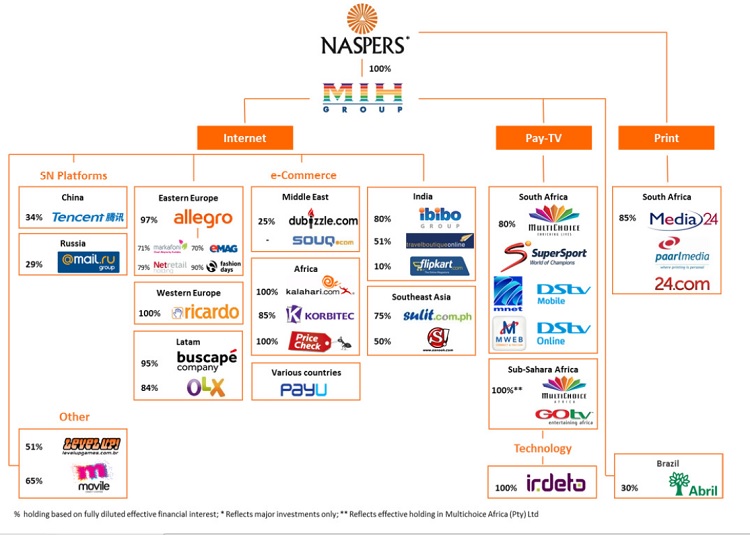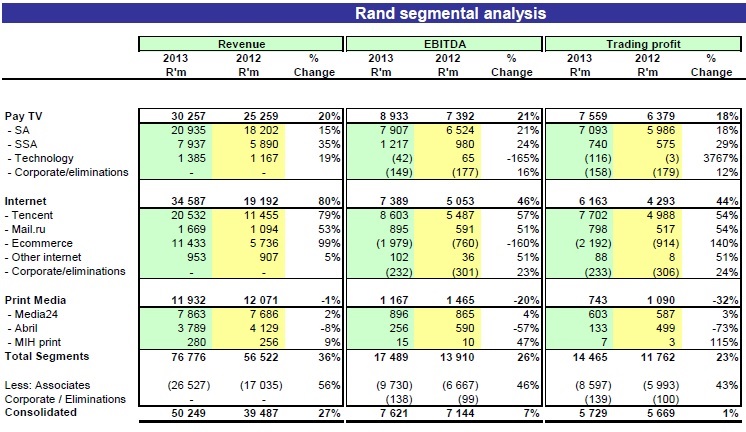Sign up for our free daily newsletter
Get the latest news and some fun stuff
in your inbox every day
Get the latest news and some fun stuff
in your inbox every day
Naspers hit screens with full year numbers this morning. The company managed to top 50 billion Rands of consolidated revenues for the first time, a 27 percent improvement on the prior year. The internet business revenues exceeded pay TV for the very first time, so I am guessing that this is a milestone of sorts for the company. Bearing in mind that the roots of the company trace back to 1915 in the Mother City with the business of newspaper and magazine (and a little while later book) publishing being their primary business. The name Naspers is a diminutive for the original Afrikaans name, De Nationale Pers, which translates in English to The National Press. A company nowadays that hardly resembles its name in any shape or form, but we will get into that.
One of the big changing points in their history was when the company decided to enter into the pay TV business. It was twenty years ago in October that they split the businesses between MNet and other, which includes the DStv business that you are familiar with today. Remember "open time" and the spare channel that was before that?!?! Those were the days my friends. They (Naspers) were quick to realise that their media assets needed to be housed elsewhere and organised the whole lot under one banner, the Media24 umbrella in 2000.
And then perhaps an amazing inspired move in May 2001, whilst the dotcom landscape looked like the Terminator 2 opening scenes, Naspers bought a 46.5 percent stake in a Chinese business called Tencent Holdings. That business Tencent listed in 2004, and the stake was diluted to 35.04 percent as at 2009. That remains, in our minds, the future of the business and the real reason why the stock has become nearly a 30 bagger over a decade. Yes. I remember a time when Naspers traded at 25 ZAR a share, the 52 week high is 758 ZAR. There is your 30 bagger right there!
Naspers have done lots of other interesting deals along the way, their corporate profile suggests that they are going to continue to be a media and ecommerce platform outside of the traditional English speaking world. Think Amazon, eBay, Facebook, Twitter and so on in many different languages. They hold these types of internet businesses in places like Russia, Brazil, Latin America and most importantly China. Plus remember that their pay TV business is and has been better than they may have anticipated. We will focus on their emerging market internet businesses and in particular Tencent and then of course their DStv/Multichoice business, seeing as those two are the main contributors. And then their big growth business, ecommerce, that will be the third focus.
To get a full layout of what the business looks like, the company presents from time to time a really great diagram that helps investors. A picture...... you know, is supposed to tell 1000 words. In this case I am guessing that it is closer to 2000 words worth of writing:

So there you go, you now know what the group looks like for now, you can add a couple of other parts to their business over the coming months, the company never keeps still!
Time to chew into the meaty parts, or crunch the carrot, if that is your thing. Again, I used the company resources (Rand segmental analysis) to shrink this pdf file the correct width. Here goes, I want you to pay particular attention to the three big items there, Pay TV (both South Africa and their rest of Africa business), Tencent and ecommerce.

First things first, Tencent. The business registered a record number of concurrent users, topping 173 million users. Their total user base grew to 564 million folks, or roughly 42 percent of the entire Chinese population. That sounds like a lot! That is what the Naspers release says, the Tencent website suggests nearly 800 million users. Tencent revenues grew a whopping 79 percent, boosted in Rand terms by a weaker currency. In fact the weaker Rand boosted all international revenues. But Tencent is an interesting business, and like we said, perhaps the future of the Naspers business for now.
Tencent is a mix of chat and messaging (QQ and WeChat), gaming, ecommerce, online advertising and other online media. Tencent has market share in the worlds biggest country by population, and offer the services that multiple companies do in the US. The business is run by the founders, Pony Ma, who is a remarkable entrepreneurial fellow. Together with Tony Zhang the chief technology officer, another founder and Daniel Xu who is the chief information officer (another founder), the business has a very good team! Naspers continues to back this team and their business, the risks are always present with Chinese internet policy looking inwards. When the walls come down, the challenge will be to compete hard against their developed world peers looking for market share. The longer the walls stay up, I guess the better for Tencent.
Next, their DStv business, their giant that they were able to leverage off and acquire all these other interesting businesses. I was absolutely amazed that a business that some folks view as "mature" was able to grow revenue by 20 percent. They added 1.1 million subscribers to bring the total base to 6.7 million. The greatest thing about this business is, if you don't pay, you get suspended. As we often say around here, the power of football on the sports channel is the force that takes people over the tipping point, as far as quality programming and switching to satellite TV. And as they mention in the release, Supersport contributes more to sport in Africa than all the collective governments. Think about that for a little. I am guessing however that the sports administrators have a pretty good time, because, you know, they are worth it!!! A fantastic and profitable business with trading profits 18 percent better to 7.6 billion. Although paying Rands for Dollar based programming has its drawback!
Great business. BUT! The Naspers release says the following: "A significant shift is visible in user activity moving from the personal computer to mobile devices such as smartphones and tablets. This trend simultaneously disrupts existing business models and creates new opportunities." And Koos Bekker said that the pay TV business was becoming somewhat of a sideshow. What he means is that he can see developments of a shift to tablets and smartphones for peoples viewing choices in developed markets, away from TV's. And as such, he needs to view this business as a mature business, with strong growth potential across the rest of the continent. But, its time will come, as the print media business gave way to the present giants.
Lastly, the ecommerce business grew at a crackerjack pace, but you can see that was largely acquisitive growth. Here is the trick you see, this business segment is what Koos Bekker sees as the future. The business will continue to grow rapidly in emerging markets and to a certain extent be in catch up mode with developed markets where Amazon is as available as a platform as any other. The delivery mechanisms are important, I am sure that they are working hard in that regard. For the mean time, as a collective this business is not likely to register meaningful profits any time soon. "Ecommerce revenues doubled to R11,4bn, through a combination of organic growth and a few acquisitions. We extended the breadth of our products, with particular emphasis on etailing and online classifieds. As we are in the building phase, this segment is presently loss-making and we do not expect profits in the aggregate for several more years."
OK, the valuations part of the business are perhaps the trickiest part for many to understand, including ourselves I will have you know! There are the earnings which will in one part lay out the simple fundamental valuation metrics and the stock (always) looks expensive and then there are the NAV calcs. I think that it is always worth looking at both. First, the NAV part!
I sent this email to a journalist on Friday, I have updated the amounts for this morning, both the exchange rates and the Tencent (and Naspers) market capitalisations. So the updated value of Tencent implied in the Naspers market capitalisation is as follows: